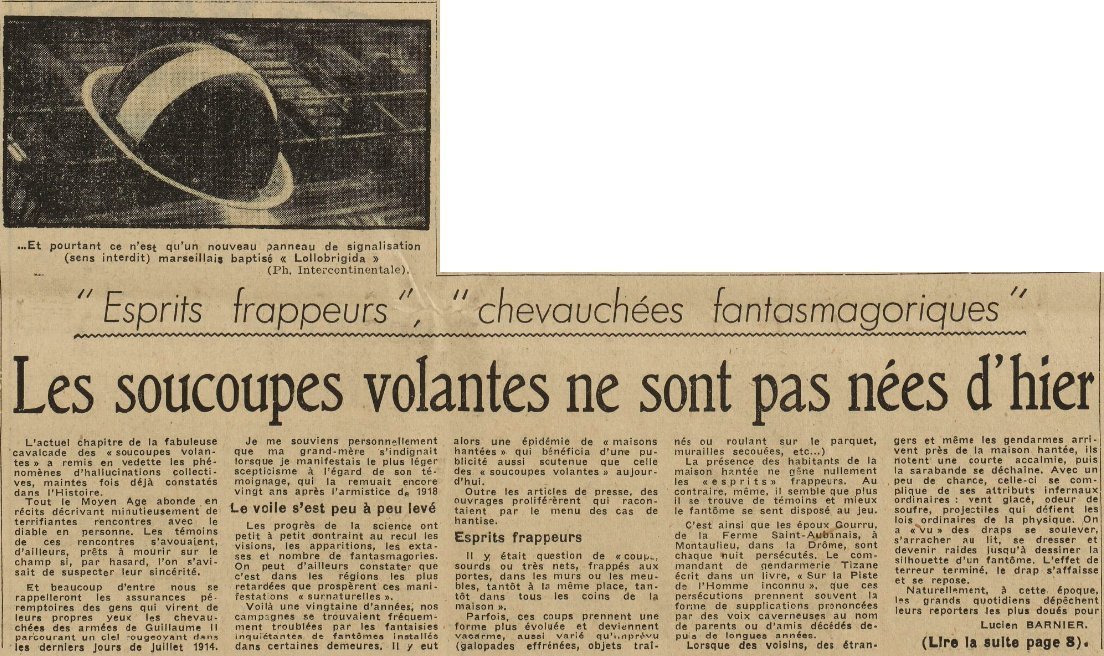The article below was published in the daily newspaper Le Patriote de Nice et du Sud-Est, Nice, France, pages 1 and 8, on October 16, 1954.

|
[Image caption:] ... And yet it's only a Marseille traffic sign ("no entry") nicknamed “Lollobrigida”
(Ph. Intercontinentale).
The current chapter in the fabulous cavalcade of “flying saucers” has brought collective hallucination phenomena back into the spotlight—phenomena that have been documented many times throughout history.
The entire Middle Ages is full of accounts describing in detail terrifying encounters with the devil himself. The witnesses of these encounters were, in fact, ready to die on the spot if anyone dared question their sincerity.
And many of us will recall the firm assurances of those who claimed to have seen, with their own eyes, the ghostly cavalcades of Kaiser Wilhelm II's armies marching across a reddened sky in the final days of July 1914.
I personally remember that my grandmother would become indignant whenever I expressed even the slightest skepticism about her testimony, which still moved her deeply twenty years after the 1918 armistice.
Scientific progress has gradually forced a retreat of visions, apparitions, ecstasies, and various forms of phantasmagoria. One can also note that these supernatural manifestations thrive most in the most underdeveloped regions.
Some twenty years ago, our countryside was often disturbed by the unsettling antics of ghosts inhabiting certain homes. There was then an epidemic of haunted houses that received just as much publicity as today's “flying saucers.”
In addition to newspaper articles, books proliferated that recounted in detail cases of haunting.
These stories spoke of dull or very sharp knocks, struck on doors, walls, or furniture, sometimes in the same place, sometimes from all corners of the house.
Sometimes, these noises took a more elaborate form and turned into a racket, as varied as it was unexpected (frenzied galloping, objects dragged or rolling across the floor, walls being shaken, etc...)
The presence of the inhabitants of the haunted house did not disturb the poltergeists in the slightest. On the contrary, it seemed that the more witnesses there were, the more eager the ghost was to play along.
This is how the Gourru couple of the Saint-Aubanais Farm in Montaulieu, in the DrĂ´me region, are tormented every night. Commander of the gendarmerie Tizane writes in a book, *On the Trail of the Unknown Man*, that these persecutions often take the form of pleas spoken by cavernous voices in the name of long-deceased relatives or friends.
When neighbors, strangers, and even gendarmes arrive near the haunted house, there is a short lull, followed by a furious uproar. With a bit of luck, this uproar is accompanied by the usual infernal signs: icy wind, smell of sulfur, projectiles defying the normal laws of physics. People have “seen” sheets lift up, tear off the bed, stand upright, and become stiff enough to form the outline of a ghost. Once the terror subsides, the sheet collapses and settles down.
Naturally, at the time, the major newspapers sent their most talented reporters to cover the events.
Lucien BARNIER
(Read more on page 8.)

|
(Continued from page 1)
The sensational takes precedence, and it's on the front page that detailed accounts of these strange ghostly exhibitions are published.
No one bothers to seek a scientific explanation. They gather the detailed stories of the most bewildered witnesses, who are often the least perceptive. These newspapers give greater prominence to such news items—especially if, at the same time, the government, encountering some difficulties, needs a bit of respite and discretion.
No doubt we will soon come to understand the many forms of the “flying saucer” hoax, just as many ghost hoaxes have been uncovered before.
On that note, scientists have revised the understanding of visual hallucinations. The image created by the brain—following the reverse path of normal vision—is transmitted to the retina. And the hallucinating person (without knowing it) would swear they actually saw the vision they imagined.
Without needing to look for extraordinary cases, who hasn't thought they heard a knock or the doorbell ring, only to find that no one had done either?
In most haunting cases, such as in Trébeurden in 1939, weak seismic phenomena were observed—minor tremors but intensely amplified in specific locations. It has also been noted that among the witnesses or victims of phantasmagoria, children or unusually developed individuals are often involved.
In 1846, the Academy of Sciences was informed of strange events occurring in La Perrière, in the Orne region. Numerous objects were moving in inexplicable ways.
A scientific commission visited La Perrière and witnessed a heavy table fall. Someone had the idea to examine one of the young girls present at this ghostly demonstration, Mlle Angélique Cottin. The girl's knee bore the mark of a bruise. When pressed with questions, Angélique Cottin admitted that she “acted as a medium for the spirits and knocked over the furniture and objects herself.”
This story closely resembles that of that merry prankster from the North, who recently manufactured dozens of flying saucers perfectly matching the classic descriptions, right down to the famous orange glow.